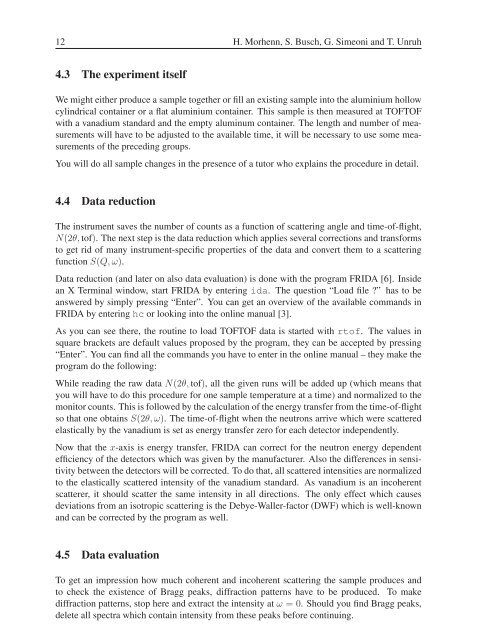Neutron Scattering - JUWEL - Forschungszentrum Jülich
Neutron Scattering - JUWEL - Forschungszentrum Jülich
Neutron Scattering - JUWEL - Forschungszentrum Jülich
Create successful ePaper yourself
Turn your PDF publications into a flip-book with our unique Google optimized e-Paper software.
12 H. Morhenn, S. Busch, G. Simeoni and T. Unruh<br />
4.3 The experiment itself<br />
We might either produce a sample together or fill an existing sample into the aluminium hollow<br />
cylindrical container or a flat aluminium container. This sample is then measured at TOFTOF<br />
with a vanadium standard and the empty aluminum container. The length and number of measurements<br />
will have to be adjusted to the available time, it will be necessary to use some measurements<br />
of the preceding groups.<br />
You will do all sample changes in the presence of a tutor who explains the procedure in detail.<br />
4.4 Data reduction<br />
The instrument saves the number of counts as a function of scattering angle and time-of-flight,<br />
N(2θ, tof). The next step is the data reduction which applies several corrections and transforms<br />
to get rid of many instrument-specific properties of the data and convert them to a scattering<br />
function S(Q, ω).<br />
Data reduction (and later on also data evaluation) is done with the program FRIDA [6]. Inside<br />
an X Terminal window, start FRIDA by entering ida. The question “Load file ?” has to be<br />
answered by simply pressing “Enter”. You can get an overview of the available commands in<br />
FRIDA by entering hc or looking into the online manual [3].<br />
As you can see there, the routine to load TOFTOF data is started with rtof. The values in<br />
square brackets are default values proposed by the program, they can be accepted by pressing<br />
“Enter”. You can find all the commands you have to enter in the online manual – they make the<br />
program do the following:<br />
While reading the raw data N(2θ, tof), all the given runs will be added up (which means that<br />
you will have to do this procedure for one sample temperature at a time) and normalized to the<br />
monitor counts. This is followed by the calculation of the energy transfer from the time-of-flight<br />
so that one obtains S(2θ, ω). The time-of-flight when the neutrons arrive which were scattered<br />
elastically by the vanadium is set as energy transfer zero for each detector independently.<br />
Now that the x-axis is energy transfer, FRIDA can correct for the neutron energy dependent<br />
efficiency of the detectors which was given by the manufacturer. Also the differences in sensitivity<br />
between the detectors will be corrected. To do that, all scattered intensities are normalized<br />
to the elastically scattered intensity of the vanadium standard. As vanadium is an incoherent<br />
scatterer, it should scatter the same intensity in all directions. The only effect which causes<br />
deviations from an isotropic scattering is the Debye-Waller-factor (DWF) which is well-known<br />
and can be corrected by the program as well.<br />
4.5 Data evaluation<br />
To get an impression how much coherent and incoherent scattering the sample produces and<br />
to check the existence of Bragg peaks, diffraction patterns have to be produced. To make<br />
diffraction patterns, stop here and extract the intensity at ω =0. Should you find Bragg peaks,<br />
delete all spectra which contain intensity from these peaks before continuing.

















